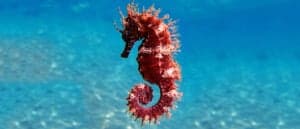Seahorses remain one of the ocean’s most interesting residents. With their trumpeted snouts, nearly-useless dorsal fin, and chameleon-like eyes, seahorses take the cake for one of the world’s most unique fish.
While seahorses themselves are stunning and delicate creatures, the male seahorse separates itself even more by being only one of two animals in the entire world that carries the burden of gestation of its young. That’s right — male seahorses really do give birth.
Learn more about how male seahorses give birth and 17 other incredible facts about seahorses.
17 Astounding Seahorse Facts
Across the 46 species of seahorses, these tiny upright swimmers have some pretty interesting behaviors, habits, and anatomy.
1. Male Seahorses Do Give Birth
A much-loved animal fun fact is that male seahorses give birth. However, the process is more nuanced than what that statement asserts.
Male seahorses don’t produce eggs or have a uterus. Instead, they have a brood pouch as part of their anatomy which accepts unfertilized eggs from the female. Located under their anal fin, the male brood pouch looks similar to a kangaroo’s pouch. It lies on the front of their bodies along the front side of their tail and near their abdomen.
After receiving eggs from the female seahorse, The male fertilizes the eggs and incubates them for around 24 days, but full gestation periods vary between nine and 45 days. When it’s time for birth, the males do a series of sit-up-like movements to contract and expand their abdomen muscles until the babies spill out.
Surprisingly, males often mate with their partner mere hours or days after birth.
2. Seahorses Are Monogamous, but Don’t Mate for Life
Seahorses remain among the few animals that choose to remain monogamous during a breeding season, but that doesn’t mean they mate for life. Instead, they’ll choose a partner with which to breed for a certain period of time. Mating season begins around February and stretches through the fall into October.
Because of a lack of research, scientists haven’t discovered the extent of seahorse monogamy, especially between species. What they do know is some species are more apt to fidelity than others — but most will choose to stray from their partner if a more viable opportunity arises.
3. Courtship Takes Several Days
Seahorses have a complex dance composed of four phases to attract and maintain a mate.
- Phase 1: Beginning just after dawn, males and females will come together after a night apart and brighten their colors to engage with each other. There is a vibrating, quivering, side-to-side movement that they do to show interest. This usually lasts less than an hour.
- Phase 2: In the second phase, the seahorses form a sort of X with each other — the female points her body toward the male and leans in while the male leans away and continues to quiver. After this phase, the seahorses take a break from courtship for up to four hours.
- Phase 3: Similar to Phase 2, in Phase 3 females again don the pointing position and brighten their coloring. The male brightens and points as well; after the display is finished, the male leaves.
- Phase 4: Finally, the seahorses come together facing each other and rise in a water column five to eight times before ending in copulation — the female inserts her ovipositor into the male brood pouch and deposits unfertilized eggs.
After the courting ends in copulation, the female finds a place to rest while the male begins fertilizing the eggs, provides nutrients, and prepares for birth.
4. Males Carry the Female’s Eggs
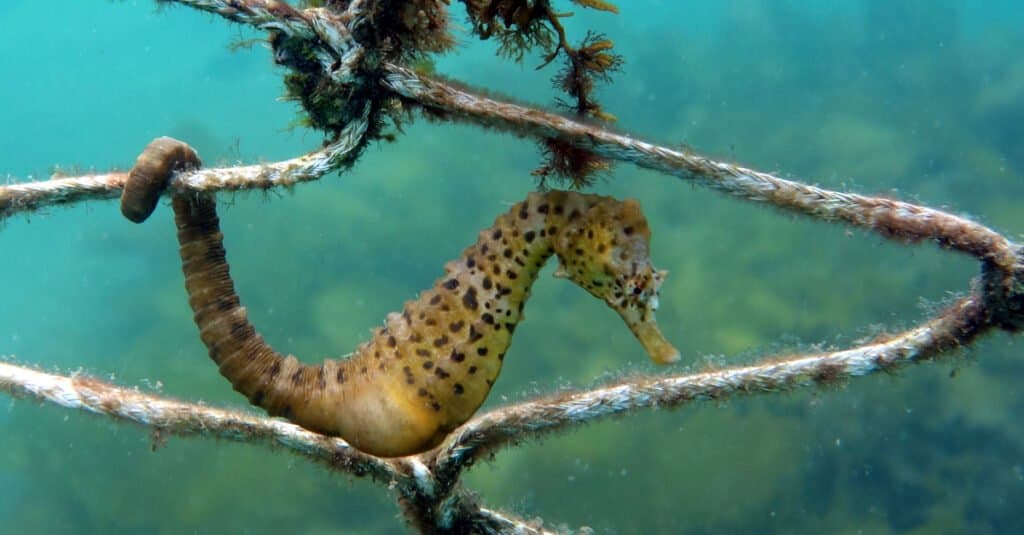
The brood pouch will incubate seahorse babies until they’re ready to make it on their own.
©Dirk van der Heide/Shutterstock.com
Male seahorse bodies have specially designed brood pouches to gestate and oxygenate the growing baby seahorses (“frys”). During the mating process, males open their brood pouches to suck in a large amount of seawater, which in turn signals the father is ready to receive the eggs. It also helps activate hormones that start the fertilization process.
These brood pouches have the responsibility of transporting nutrients to the incubating seahorses. Energy-rich fats and other necessary nourishments fill the brood pouch to ensure fully-developed babies at their time of expulsion.
5. Male Seahorses Have Smaller Snouts
Compared to female seahorses, male seahorses in nearly every species have a smaller snout. The size of the snout is pretty hard to catch, unless you’re looking for it, so it’s not the best distinguisher if you’re trying to tell a male and female seahorse apart.
Seahorse snouts act as vacuums that both suck in passing by nutrients and dig into nooks and crannies to find food. Without a stomach or nuanced digestive system, seahorses can only suck up what’s small enough to fit into their snout and disintegrate.
6. They Sleep with Their Eyes Open
Seahorses sleep with their eyes open — not because they’re watching their back, but because they don’t have eyelids to close.
Regarding seahorses’ eyes: they’re like a chameleon’s, and each moves independently. When they are awake, seahorses have a wide berth of vision to locate prey or danger.
7. Male Seahorses Dance When Courting
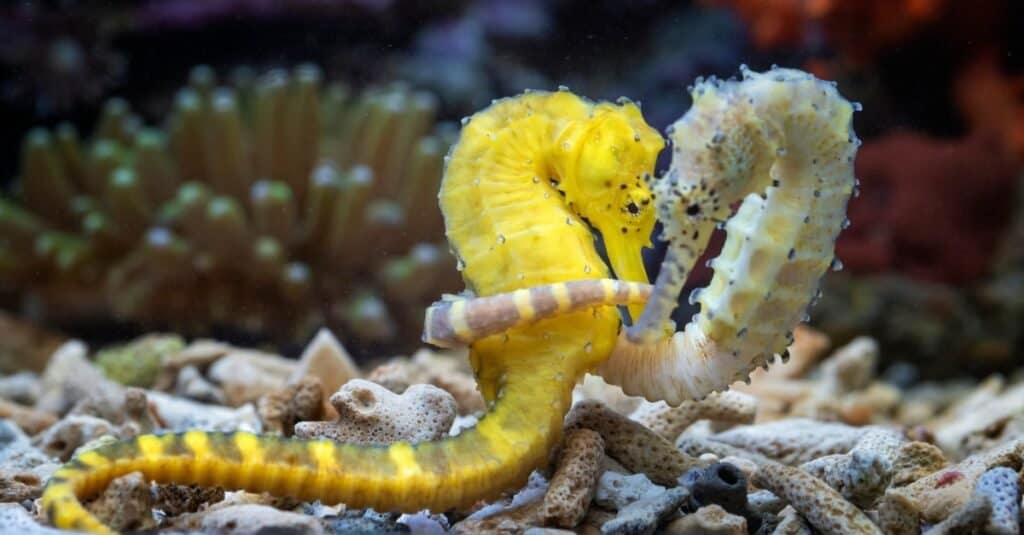
Seahorses entwine their tails during the courtship process.
©Bernard S Tjandra/Shutterstock.com
As mentioned above, the seahorse courting process involves a lot of dancing. Males do the majority of the dancing in the process to demonstrate that they’re a strong and viable option as a partner.
This dancing does a few things: it assesses reproductive status, reinforces bonds, and even has health benefits for the male (depending on which part of the courtship dance you talk about).
8. Seahorses Eat a Lot
Did you know that seahorses can eat up to 50 times a day? They have to because their small bodies don’t process food and nutrients well, allowing most of what they capture in their snouts to leave their bodies. In addition, seahorses furiously beat their dorsal fin to move or propel themselves forward, which costs a ton of energy.
Seahorses need to be smart and stealthy if they want to eat. They can’t swim to catch their prey, so they rely instead on camouflage and sneak attacks to suck up prey small enough for their snouts.
9. They Are Poor Swimmers
With a measly dorsal fin and even smaller fins on the backs of their heads used to change directions, it’s safer for seahorses to anchor themselves to coral. This way, they can camouflage their presence rather than float in the open ocean without a way to protect themselves or avoid predators. The dwarf seahorse is the slowest species — only able to travel 5 feet in a full hour of swimming.
Interestingly, though, seahorses are one of the only fish that can swim upright. Seahorses also face death by exhaustion if a particularly bad storm influences the currents or waves and the seahorse tries to escape.
10. Seahorses Can Camouflage Well
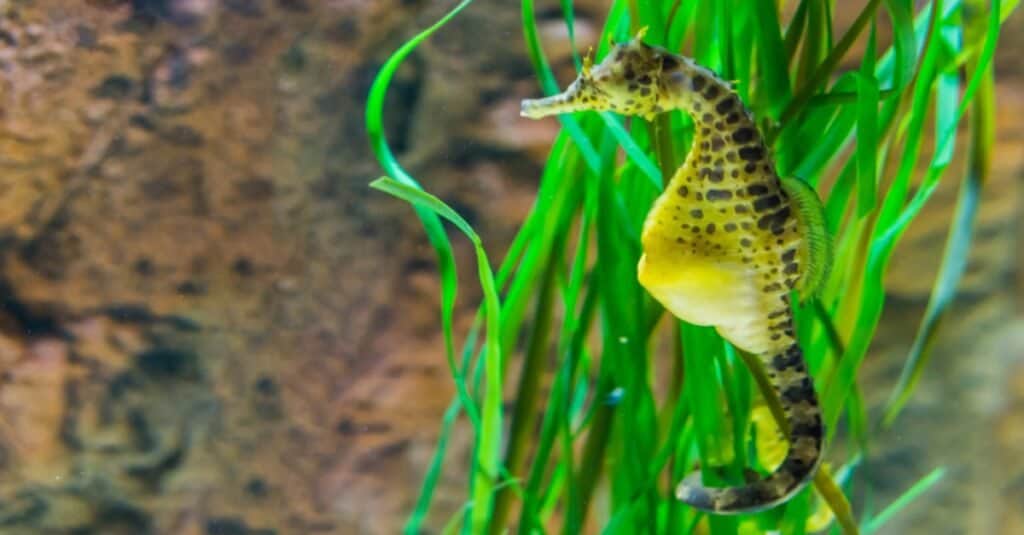
Did you know the seahorse’s hunting technique gives them an impressive 90% successful predatory kill rate?
©Charlotte Bleijenberg/Shutterstock.com
With the ability to latch onto stationary objects and change their coloring — as well as a uniquely boney appearance — seahorses are built to hide in plain sight.
While not all seahorses can change the color of their skin to suit their environment, those that aren’t usually already have the perfect coloring to blend into their surroundings.
11. They Don’t Have Teeth or Stomachs
Without stomachs or teeth — but with a massive appetite — its astounding seahorses have made it this far in their evolution. Instead of teeth and a stomach, the seahorse has a trumpeted snout with a tube it can use like a vacuum, as well as a poorly-designed digestive system.
Seahorses use their tubed snout to suck in animals small enough to capture, like amphipods and plankton, which then pass through an inefficient digestion system. This is why seahorses can (and must!) eat so often.
12. Seahorse Are Considered Fish
Though incredibly bony and lacking scales, seahorse species do belong to the Chordata, or fish, phylum.
The classification of a fish remains “any aquatic vertebrate animals that have gills but lack limbs with digits, like fingers or toes.” Seahorses fit this mold — they cannot breathe out of water, have a single tail and small fins to propel themselves, and are made up of many vertebrates.
While seahorses may not have fingers, they have been known to use their monkey-like tails to hold researchers’ hands! In reality, they’re simply anchoring themselves in water, but experts have found that the fish actually enjoy being handled by humans.
13. Male Chests Have a Small Ridge
While it’s almost imperceptible to the eye, male seahorses in many species have a “keel,” or an extra chest ridge, over their female counterparts. This chest ridge doesn’t serve an additional purpose other than to distinguish males from females.
Seahorse chests double as armor-covered plates that protect a seahorse’s internal organs in lieu of scales. Scientists use trunk rings (which sit below their neck and above their anal fins) to decipher the species of seahorse an animal is.
14. Seahorses Aren’t Prey to Many Predators
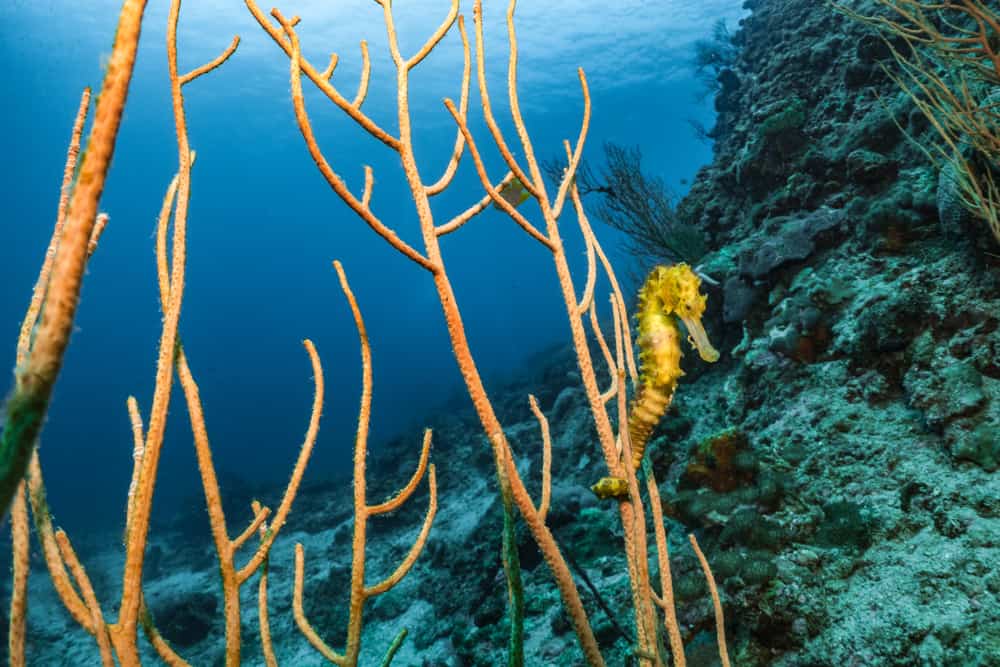
Not many predators go after seahorses. Those that do choose it as a last resort.
©Adam Leaders/Shutterstock.com
While some number their predators at over 50 different animals, seahorses really aren’t that big of a prize for many animals. Their bony structure and overall lack of meat makes
Overall, crustaceans reign at the most dangerous predator seahorses face in their regular environments. Larger animals and mammals like fairy penguins, tuna, and rays will eat seahorses but usually choose to do so as a last resort.
Unfortunately, one of the biggest threats to seahorses is human impact. Humans, especially in Asian countries, harvest seahorses for food and other uses faster than the species can reproduce.
15. Male Seahorses Commonly Eat Their Young
Black widows aren’t the only creature in the animal kingdom to feed on their young.
While not overtly common, male seahorses have been known to feed on their frys after birth. This phenomenon usually happens after a male gives birth but hasn’t gotten enough nutrients or food after to sustain himself. Mothers can and will eat their babies too, but dads are more prone to the practice because they exert themselves more in the birthing process and must find nearby nutrients.
This doesn’t mean seahorses are cannibals, though. Usually, parents will look for any other food source before turning to the frys.
16. Baby Seahorses Fend for Themselves
At birth, frys are on their own. Often, they spend their first few weeks of life floating along with other microscopic organisms like plankton. Because they’re expelled by their dad in large groups, frys will often group together and connect to each other with their tails.
Only the size of a jelly bean (and sometimes smaller), frys immediately must hunt for and protect themselves — which is why staying in a group makes sense. Out of a brood of hundreds, or even a few thousand, it’s not uncommon that only a handful of frys mature and grow to make their own way in the ocean. A large percentage of frys die from predators, which is why the breeding season produces so many babies.
17. Their Tails Keep Them Alive
Seahorses use a prehensile tail to survive.
Because they’re such poor swimmers, seahorses rely on their tails to anchor them to coral or other stationary objects. These tails come in handy in many ways — they help create a believable camouflage for the seahorse when attached to coral, it prevents them from drifting away from home during sleep, and it provides a sturdy perch for gathering food by sucking through their snout. In some instances, their tails can even snap up dinner.
Seahorse tails look circular, but the base is actually square. It’s pretty flexible too, as often seen by its spiral-like shape.
Common Misconceptions About Male Seahorses
As discussed earlier, male seahorses don’t become “pregnant” in the conventional sense. Instead, their brood pouch incubates the unfertilized eggs provided by the mom (that are fertilized after depositing into the father) and ensures enough nutrients get to the frys so they gestate into fully-functional seahorses when they’re expelled from the pouch.
Despite the fact they’re poor swimmers, seahorses aren’t necessarily homebodies. They can travel long distances by attaching themselves to seaweed or other debris. Seahorses choose to travel when their habitat or environment becomes either dangerous or lacks the food, shelter, or mates they need to survive.
Most species of seahorses can change color at least a little, and that change is a result of their mood, the environment’s lighting, and more. Seahorses can become darker when stressed and lighter or more colorful when excited by their mate.
How Are Female and Male Seahorses Different?
For the most part, female and male seahorses remain the same. They look similar and if they are sexually immature, the body and behavior of male and female seahorses are almost identical. As they mature, there are slight differences, including:
- An extra bone structure on the male’s chest.
- Different reproductive organs.
- Separate responsibilities in rearing young.
Neither the mother nor the father seahorse parents the young; instead, they simply reproduce to further the species’ ability to survive.
Are Seahorses Similar To Sea Dragons?

Kind of. While seahorses and sea dragons belong to the same family of animals (Syngnathidae), they differ in a number of ways, including their size, appearance, environment, and diet.
The only striking similarity between seahorses and sea dragons is that male sea dragons also raise embryos. However, sea dragons carry them on their tails rather than internally.
Seahorses Are Fascinating Creatures
Not only do male seahorses give birth — they carry the burden of the gestational period to birth fully-developed young! Seahorses remain interesting fish and quite unique members of the Chordata family. Learn more about seahorses, their many species, and what they eat.
The photo featured at the top of this post is © Vojce/Shutterstock.com
Thank you for reading! Have some feedback for us? Contact the AZ Animals editorial team.






